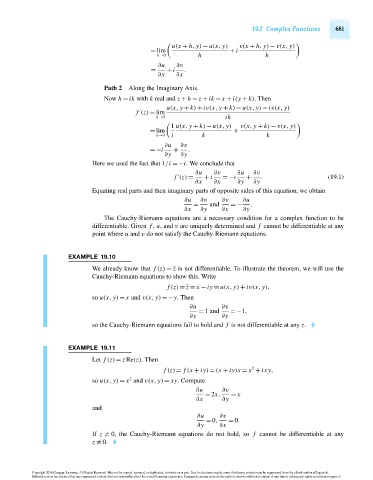Page 701 - Advanced_Engineering_Mathematics o'neil
P. 701
19.2 Complex Functions 681
u(x + h, y) − u(x, y) v(x + h, y) − v(x, y)
= lim + i
h→0 h h
∂u ∂v
= + i .
∂x ∂x
Path 2 Along the Imaginary Axis.
Now h = ik with k real and z + h = z + ik = x + i(y + k). Then
u(x, y + k) + iv(x, y + k) − u(x, y) − iv(x, y)
f (z) = lim
k→0 ik
1 u(x, y + k) − u(x, y) v(x, y + k) − v(x, y)
= lim +
k→0 i k k
∂u ∂v
=−i + .
∂y ∂y
Here we used the fact that 1/i =−i. We conclude that
∂u ∂v ∂u ∂v
f (z) = + i =−i + . (19.1)
∂x ∂x ∂y ∂y
Equating real parts and then imaginary parts of opposite sides of this equation, we obtain
∂u ∂v ∂v ∂u
= and =− .
∂x ∂y ∂x ∂y
The Cauchy-Riemann equations are a necessary condition for a complex function to be
differentiable. Given f , u, and v are uniquely determined and f cannot be differentiable at any
point where u and v do not satisfy the Cauchy-Riemann equations.
EXAMPLE 19.10
We already know that f (z) = z is not differentiable. To illustrate the theorem, we will use the
Cauchy-Riemann equations to show this. Write
f (z) = z = x − iy = u(x, y) + iv(x, y),
so u(x, y) = x and v(x, y) =−y. Then
∂u ∂v
= 1 and =−1,
∂x ∂y
so the Cauchy-Riemann equations fail to hold and f is not differentiable at any z.
EXAMPLE 19.11
Let f (z) = z Re(z). Then
2
f (z) = f (x + iy) = (x + iy)x = x + ixy,
2
so u(x, y) = x and v(x, y) = xy. Compute
∂u ∂v
= 2x, = x
∂x ∂y
and
∂u ∂v
= 0, = 0.
∂y ∂x
If z = 0, the Cauchy-Riemann equations do not hold, so f cannot be differentiable at any
z = 0.
Copyright 2010 Cengage Learning. All Rights Reserved. May not be copied, scanned, or duplicated, in whole or in part. Due to electronic rights, some third party content may be suppressed from the eBook and/or eChapter(s).
Editorial review has deemed that any suppressed content does not materially affect the overall learning experience. Cengage Learning reserves the right to remove additional content at any time if subsequent rights restrictions require it.
October 15, 2010 18:5 THM/NEIL Page-681 27410_19_ch19_p667-694

